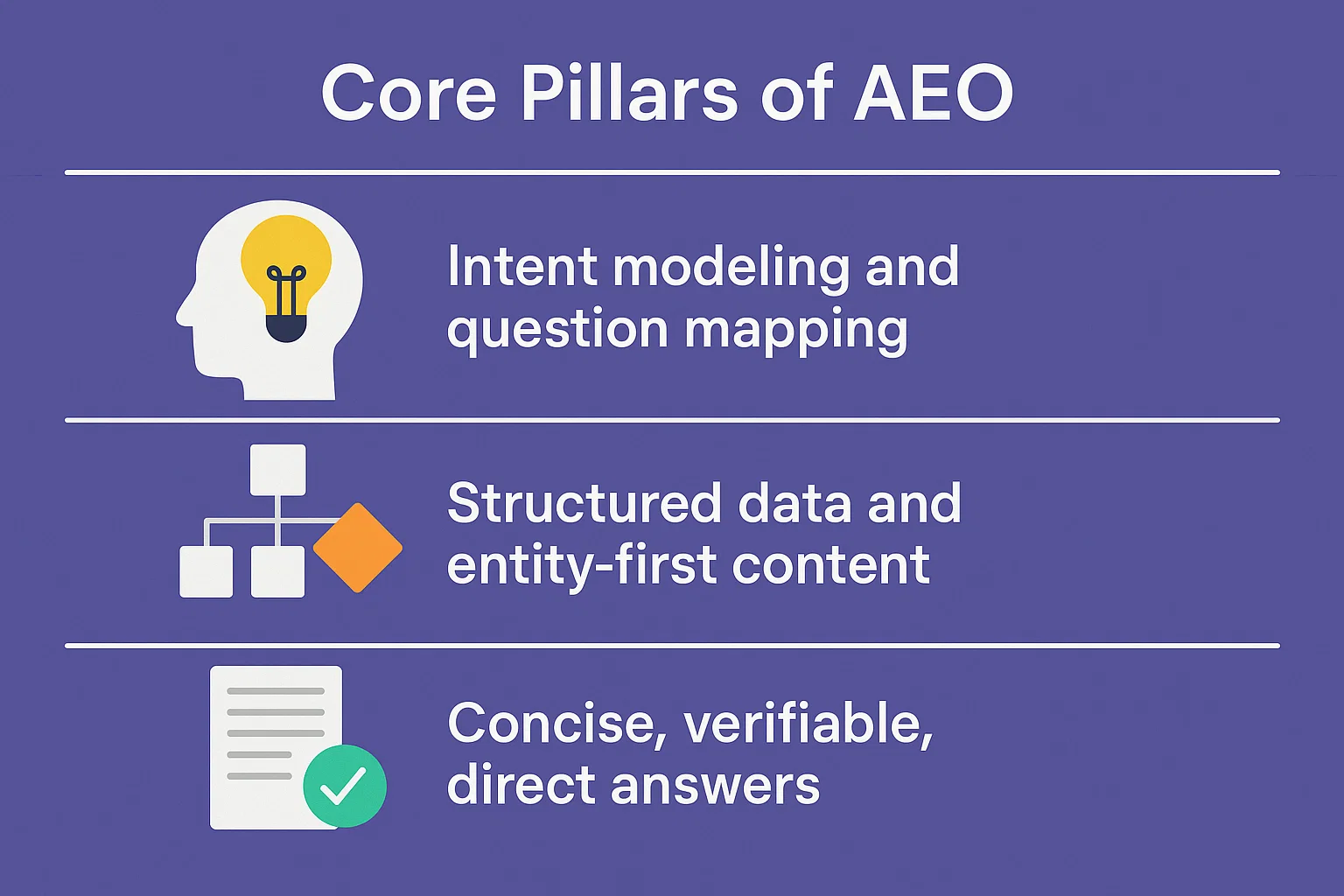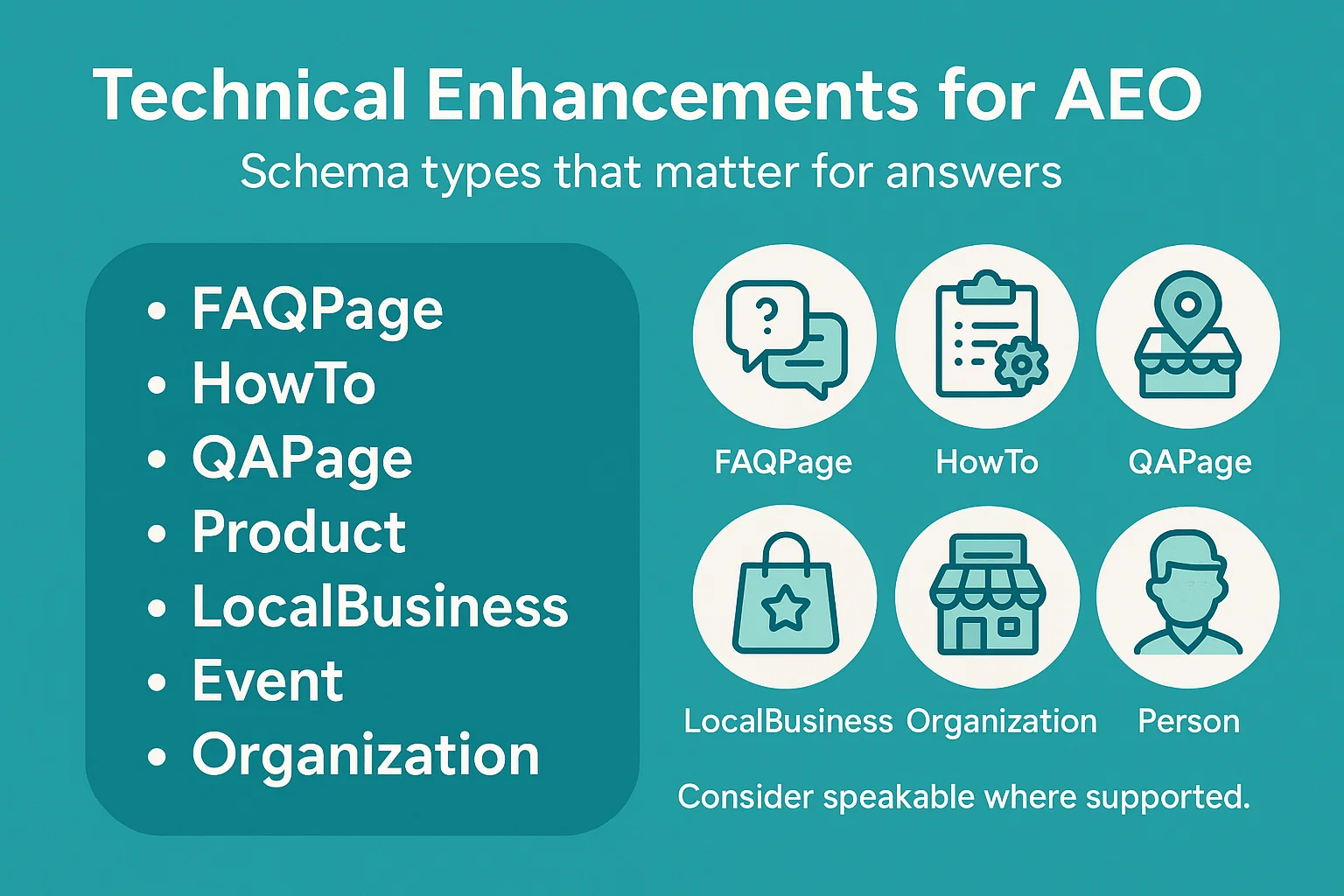Quick Definitions
What is SEO (Search Engine Optimization)?
SEO is the practice of improving your site’s visibility in traditional search engines like Google and Bing.
It focuses on ranking webpages for specific queries so users click through to your site.
Core levers include technical health, on-page relevance, links, and authority.
What is AEO (Answer Engine Optimization)?
AEO, or Answer Engine Optimization, is quickly becoming a core part of digital strategy for any brand that wants to stay visible in today’s search landscape. The idea is simple: you structure your content so that AI-driven tools—voice assistants, chatbots, or those featured answer boxes at the top of search results—can instantly find and showcase your information as the best answer. But there’s more to it than just showing up.
In business, visibility equals opportunity. When your content gets picked as the direct answer, you’re not just getting your name out there—you’re establishing authority. People start associating your brand with expert knowledge. And you don’t have to wait for someone to click a link; your brand becomes the answer itself, whether that’s in a quick Google snippet, an AI summary, or a voice response from Alexa or Siri. This kind of exposure builds trust and puts your business at the center of key purchasing decisions.
But AEO isn’t just about visibility. It’s about making sure the information people find is accurate, up-to-date, and clearly attributed to your brand. That clear brand attribution drives demand—and it nudges potential customers further down the sales funnel. When people hear or see your brand as the go-to source, they’re more likely to choose you when it’s time to buy.
In short, Answer Engine Optimization helps your business own the conversation. By putting your brand in the spotlight, you turn every answer into a chance to connect, influence, and convert. That’s how modern brands win in an AI-driven world.
The Shift from “Links and Keywords” to “Answers and Intent”

How search behavior is changing
1) From keywords → natural language with constraints
People no longer type “running shoes.” They ask full questions with built-in filters:
-
“What’s the best shoe for overpronation for half marathons under £150?”
-
“How do I set up SAML SSO in under 30 minutes without downtime?”
These queries pack intent, context, and constraints (budget, time, skill level, condition) into one sentence.
2) From one-shot searches → multi-turn conversations
Search is dialog now. Users refine in steps:
-
Q1: “Best camera for wildlife photography?”
-
Q2: “Make that mirrorless.”
-
Q3: “Under £1,000 and good autofocus.”
Answer engines remember context, so content must stand alone and chain logically to the next question.
3) From “click to learn” → “see the answer here”
Zero-click surfaces—featured snippets, answer cards, AI overviews—often satisfy the query without a visit. That’s not a loss if your brand is:
-
Cited as the source
-
Clear and quotable in 40–80 words
-
Offering an obvious next step (tool, calculator, guide)
4) Voice and hands-free queries
Spoken queries are longer and more casual (“How do I clean suede shoes fast?”). Voice prefers:
-
Short, definitive answers
-
Step-by-step formats
-
Simple phrasing that sounds natural when read aloud
5) Multimodal search (text + image + video)
People search with photos, screenshots, and short clips:
-
“What plant is this?” (photo)
-
“Identify this part and show me how to replace it.” (image + how-to)
Content that includes clear images, captions, alt text, and diagrams wins more of these moments.
6) Personal and situational context
Location, device, past queries, and immediate needs shape results:
-
“Coffee near me that’s open now.”
-
“Best VPN for traveling to Europe for 2 weeks.”
Reflect this in content with clear locations, hours, pricing, and suitability (“good for commuters,” “works offline,” “kid-friendly”).
7) From information retrieval → task completion
Users want to finish a job, not just read about it:
-
Checklists, calculators, templates, sizing guides, comparison tables, and “what to do next” blocks outperform fluffy paragraphs.
8) Trust and verifiability front-and-center
When answers are aggregated, engines (and users) look for:
-
Citations, named authors, credentials, and last-updated dates
-
Consistent facts across your pages (entities, specs, definitions)
Make your claims easy to verify.
9) Price and time sensitivity baked into the query
“Under £150,” “within 24 hours,” “free alternative,” “same-day pickup.”
Don’t bury this info—surface price ranges, lead times, requirements, and trade-offs at the top.
10) Comparative intent dominates
“X vs Y,” “best for Z,” “is it worth it,” “top alternatives.”
Lead with a one-paragraph verdict, then provide pros/cons, use-case fit, and decision criteria.
11) Privacy-aware searching
Some users avoid logins or use private/alternative engines. That means:
-
Clear, non-personalized answers still need to shine.
-
Avoid requiring clicks for basic facts that could be stated succinctly.
12) Global by default
Queries mix currencies, units, and standards. Specify:
-
Prices with currency symbols
-
Units (US/metric)
-
Region-specific rules or availability
13) B2B: more stakeholders, more constraints
Professional searches add compliance, security, integration, and ROI concerns:
-
“SOC 2 compliant alternatives to X that integrate with Okta and cost under £50/user.”
Address these head-on with feature matrices, security pages, and implementation timelines.
What this means for your content (actionable takeaways)
-
Write the answer first. Start sections with a crisp 40–80-word answer; expand below.
-
Mirror natural phrasing. Use headings like “What is…?”, “How to…”, “Pros and cons,” “Cost,” “Time required.”
-
Design for follow-ups. After each answer, anticipate the next question and link to it.
-
Expose facts with schema. FAQPage, HowTo, Product, Organization, LocalBusiness where relevant.
-
Show constraints clearly. Price bands, specs, compatibility, prerequisites, time needed.
-
Be snippetable. One concept per paragraph; short sentences; definition lines that can stand alone.
-
Use comparisons. Provide verdicts, not just descriptions. Add tables for quick scanning.
-
Add helpful tools. Calculators, checklists, templates, decision trees.
-
Prove it. Cite sources, show author credentials, and date-stamp updates.
-
Refresh regularly. Revisit top pages quarterly to keep facts current and consistent.
Classic vs. modern query examples (and how to answer)
-
Classic: “best running shoes”
Modern: “best shoe for overpronation, half-marathon training, under £150”
Answer pattern: Start with a 2–3 sentence pick + why (support level, weight, durability), include price range, then 3 alternatives by use case. -
Classic: “crm software”
Modern: “privacy-first CRM with GDPR compliance, HubSpot migration, and SAML SSO, under 100 seats”
Answer pattern: Verdict + feature/security table + migration steps + total cost considerations. -
Classic: “how to prune roses”
Modern: “how to prune climbing roses in late winter in the UK, tools needed, 10-minute guide”
Answer pattern: Tools list, time estimate, season note, 5–7 numbered steps, safety tip, quick diagram or photo.
Why zero-click and conversational search matter
“Zero-click” results used to feel like the enemy. Today, they’re often the first exposure
to your brand. If your concise, authoritative answer anchors an AI overview or a rich snippet, users remember your brand,
search it later, or click the source for depth. AEO treats that moment as a
branding and trust opportunity, not a loss.
Where SEO Ends and AEO Begins
Overlap and key distinctions
- Overlap: both need solid IA, fast pages, and clear topical authority.
- Distinctions: SEO optimizes pages to rank and win clicks; AEO optimizes facts, entities,
and snippets to win answers (plus attribution).
When to prioritize one over the other
- High-intent commercial pages → SEO leads.
- Informational or pre-funnel queries → AEO can deliver massive visibility and brand recall,
then hand off to SEO-rich content for depth and conversion.
Core Pillars of Traditional SEO

Technical SEO basics (crawlability, indexation, speed)
- Clean sitemaps, proper robots rules, correct indexation.
- Core Web Vitals and predictable rendering.
- Canonicalization and pagination done right.
On-page optimization (structure, headings, schema)
- Logical H1–H4 hierarchy with one primary topic per page.
- Descriptive title/meta; internal links with anchor variety.
- Schema to clarify what the page is about.
Off-page signals (links, mentions, E-E-A-T)
- Links still matter—topical relevance and publisher trust matter more.
- Demonstrate Experience, Expertise, Authoritativeness, and Trust via credible authors,
citations, and transparent sourcing.
Core Pillars of AEO
Intent modeling and question mapping
Catalog the questions your audience asks across stages: what, how, which, should, cost, near me, vs, best for X.
Group by intent and complexity (single answer vs multi-step).
Structured data and entity-first content
Align content to entities (people, products, orgs, concepts). Use schema to expose facts, relationships,
and definitive attributes so answer engines can verify quickly.
Concise, verifiable, direct answers
Lead with a short, fact-led summary; expand below. Use TL;DRs, bullet highlights, and FAQ blocks with citations.
Write like a helpful expert on a call—clear, complete, and source-aware.
Entity SEO: The Bridge Between AEO and SEO
- Knowledge graph footprint: strong About pages, Organization/Person schema,
andsameAslinks to authoritative profiles. - Disambiguation: for local brands, consistent NAP and
LocalBusinessschema with geo-coordinates.
Content Formats that Win in AEO
- FAQs, TL;DRs, summaries, and answer boxes.
- Conversational content designed for multi-turn follow-ups.
- Pros/cons tables, numbered steps, pricing ranges, and timeframes.
Technical Enhancements for AEO

Schema types that matter for answers
FAQPage, HowTo, QAPage, Product, LocalBusiness,
Event, Organization, Person, etc. Consider speakable where supported.
Page architecture for snippetability
- Short, declarative definition paragraphs.
- Descriptive subheadings mirroring query wording.
- Lists and tables for scannability; one concept per section.
Analytics and Measurement
KPIs for SEO vs KPIs for AEO
- SEO: impressions, rankings, organic sessions, CTR, conversions.
- AEO: featured snippet share, AI overview inclusion, attributed mentions,
voice result tests, brand search lift, zero-click signals.
Tracking zero-click value
Correlate brand SERP impressions and direct/brand organic with AEO content launches.
In Search Console, look for impression spikes where CTR stays low—often an AEO signature.
Practical Workflow: From Query to Answer
- Collect questions (Search Console, People Also Ask, forums, sales/support).
- Cluster by intent: informational, navigational, transactional, post-purchase.
- Prioritize by business value, frequency, competitive gap.
- Draft 40–80 word direct answers, then expand.
- Attach schema aligned to entities.
- Add citations where appropriate; show author credentials.
- Cross-link to product/service pages or deeper guides.
- Test snippetability: does the answer stand alone?
Editorial guardrails and style templates
- Definition: “[Term] is [precise definition].”
- How-to: numbered steps with tools/time upfront.
- Comparison: verdict + pros/cons + use-case guidance.
- Pricing: range + variables + quick calculator link.
Tools and Tech Stack
- Keyword & question research tools; clustering utilities.
- Entity/NLP extraction to map concepts and relationships.
- Schema generators/validators and testing utilities.
Common Pitfalls and How to Avoid Them
- Over-optimizing for snippets: never starve pages of depth—pair concise answers with substance.
- Ignoring attribution/sources: engines prefer verifiable content with citations, bios, and review dates.
B2B vs B2C Considerations
- B2B: frameworks, decision trees, ROI-oriented summaries; executive TL;DRs plus deep dives.
- B2C: fast answers, comparisons, visuals, and checklists.
- Gating: keep basic answers ungated; gate high-value templates/reports selectively.
Future-Proofing Your Strategy
- Voice & multimodal: optimize for speakable, concise phrasing; alt text; stepwise structures for agents.
- Governance & refresh: maintain a refresh log; date-stamp updates; revisit top answers quarterly.
AEO + SEO Checklist
- H1 matches primary question/topic.
- First 80 words deliver a clean answer.
- Each section answers one specific question.
- Descriptive H2/H3s mirror user phrasing.
- FAQ block covers “People also ask” queries.
- Appropriate schema implemented.
- Entity references with
sameAslinks. - Author bios; review dates for YMYL.
- Core Web Vitals pass.
- Canonicals/indexation verified.
- Internal links to money pages.
- Pros/cons or comparison tables.
- Clear pricing/time variables when relevant.
- TL;DR summary box near top.
- Descriptive alt text for media.
- No duplicate answers across pages.
- Declarative sentences; minimal hedging.
- Cite data/studies for claims.
- Track impressions vs clicks for AEO wins.
- 90-day refresh plan.
Case-Style Examples
Informational query example
Query: “AEO vs SEO—what’s the difference?”
AEO-first answer (snippet-ready): AEO structures content so AI/answer engines can extract and present
direct, verified answers, often without a click. SEO focuses on ranking pages in traditional search to win clicks.
The best approach combines both: concise, verifiable answers plus in-depth pages that convert.
Transactional query example
Query: “Best AEO tool for FAQ schema.”
AEO-first answer: Use a schema-capable CMS or generator that supports FAQPage and
HowTo; prioritize tools that keep schema synced with on-page content to avoid mismatches.
Conclusion and Next Steps
AEO vs SEO isn’t a cage match—it’s a handshake.
Think of SEO as your building’s foundation and floor plan—solid structure, utilities, and rooms where people can actually live. AEO (Answer Engine Optimization) is your storefront signage and greeter—what people see first on the street (SERP/AI overview/voice result) that invites them in. You need both: the greeting that earns attention and the house that delivers comfort and closes the deal.
Think of SEO as your building’s foundation and floor plan—solid structure, utilities, and rooms where people can actually live. AEO (Answer Engine Optimization) is your storefront signage and greeter—what people see first on the street (SERP/AI overview/voice result) that invites them in. You need both: the greeting that earns attention and the house that delivers comfort and closes the deal.
What each side does best
SEO (the foundation & depth)
-
Makes your site discoverable and crawlable (tech SEO, Core Web Vitals, canonical/indexation sanity).
-
Proves topical authority with clusters, internal linking, and editorial depth.
-
Earns trust with E-E-A-T signals (qualified authors, citations, reviews, brand mentions/links).
-
Converts with persuasive product/service pages, rich comparison tables, case studies, calculators, and long-form guides.
AEO (the front-of-SERP visibility)
-
Wins featured snippets, AI overviews, People Also Ask, and voice answers.
-
Surfaces short, verifiable answers that satisfy intent fast.
-
Uses entity-aware structure and schema so engines can verify and attribute your facts.
-
Sets up the next click to your deeper SEO pages when the user needs more than the headline answer.
SEO provides the foundations and depth that convert.
AEO provides front-of-SERP visibility in answer engines, AI overviews, and voice results. Together, they meet users
where they are: sometimes a quick, trusted answer; other times, a deep, persuasive page. Build entity-aware content,
lead with clear, verifiable answers, and back it with robust pages that solve the whole problem—you’ll win both the
answer and the audience.
How they work together in the real journey
-
Spark with AEO
A 40–80 word, source-backed answer appears in an AI overview or snippet. You get brand exposure and often the attribution link. -
Stretch with SEO
The user clicks through to a well-structured page that expands the answer into steps, trade-offs, pricing variables, examples, and tools—moving them along the funnel. -
Seal with product & proof
Internal links, clear CTAs, social proof, and calculators close the loop from curiosity to conversion.
What “entity-aware content” actually means
-
Define your core entities (Organization, Products, Services, People/Authors, Locations, Concepts).
-
Keep names/descriptions consistent across your site and profiles; connect with sameAs links to authoritative sources.
-
Add the right schema types (Organization, Product, LocalBusiness, FAQPage, HowTo, Article, Person).
-
Use clear definition sentences and stable facts (dates, specs, ranges) that engines can verify across pages.
A simple page blueprint that blends AEO + SEO
-
TL;DR answer box (2–4 sentences) directly addressing the query.
-
Context section: when it applies, who it’s for, quick prerequisites/constraints.
-
How-to / decision steps: numbered, scannable, with time/tools.
-
Comparison or pros/cons: include a one-paragraph verdict.
-
Pricing/time ranges: why costs vary; link to a calculator or quote flow.
-
FAQs (distinct, non-duplicative) mapped to “People also ask.”
-
Schema mirroring the visible content (FAQPage/HowTo/Product/etc.).
-
Credibility: named author, reviewed-by (when YMYL), sources, last updated date.
When to lean harder on one or the other
-
AEO-first when the query is informational, time-sensitive, or answerable in <100 words (e.g., definitions, “how long/cost,” simple comparisons).
-
SEO-first when the query is commercial, complex, or decision-heavy (e.g., product selection, implementation details, ROI, compliance).
-
Both for high-value topics: open with AEO-friendly answers, then deliver SEO-grade depth.
Measurement that respects both goals
AEO KPIs
-
Featured snippet / AI overview inclusion rate and share (by topic).
-
Impressions in Search Console with flat CTR (classic zero-click signature).
-
Brand search lift and direct traffic after publishing answer-first content.
-
Voice test pass rates (manual/assistant checks on key questions).
SEO KPIs
-
Rankings for target clusters, organic sessions, time on page, and assisted conversions.
-
Link/mention quality and topical authority growth.
-
Conversion rate from answer pages → product/service pages.
Tie them together: annotate content releases; track changes in impressions, brand queries, and assisted conversions over the next 2–6 weeks.
Common mistakes (and quick fixes)
-
Chasing snippets and starving substance: keep your TL;DR, but ensure the body can sell and convert.
-
Schema mismatch: your structured data must reflect what’s on the page, not wishful thinking.
-
Duplicate FAQs everywhere: consolidate and canonicalize; answer once with authority, then link.
-
Thin E-E-A-T: add bios, credentials, citations, and review cycles—especially for YMYL topics.
-
Ignoring internal links: every answer box should point to the next best page in the journey.
FAQs
- Is AEO replacing SEO?
- No. AEO complements SEO. You still need SEO to earn rankings, traffic, and conversions. AEO helps capture answer surfaces and brand recall.
- Do featured snippets equal AEO?
- They’re one expression of AEO. True AEO also targets AI overviews, voice assistants, and multi-turn answers.
- How do I measure AEO success if clicks are low?
- Track impressions, brand search lift, attributed mentions in answer cards, voice results, and assisted conversions.
- What content format works best for AEO?
- Start with a 40–80 word direct answer, then expand. Add FAQs, how-to steps, comparison tables, and support with schema and entity signals.
- What’s the fastest way to get started?
- Pick one high-value topic. Build an Answer Map (top 10 questions), write snippet-ready answers, add schema, and link to core pages. Measure, refine, repeat.













